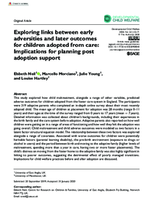Abstract
This study explored how child maltreatment, alongside a range of other variables, predicted adverse outcomes for children adopted from the foster care system in England. The participants were 319 adoptive parents who completed an in-depth online survey about their most recently adopted child. The mean age of children at placement for adoption was 28 months (range 0–11 years) and their ages at the time of the survey ranged from 0 years to 17 years (mean ¼ 7 years). Detailed information was collected about children’s backgrounds, including their experiences in the birth family and the care system before adoption. Adoptive parents also reported on how well children were getting on in a range of areas of functioning and how well they felt the adoption was going overall. Child maltreatment and child adverse outcomes were modeled as two factors in a latent factor structural equation model. The relationship between these two factors was explored alongside a range of covariates. Associated with worse outcomes for children were potentially heritable factors (parental learning disability), the pre-birth environment (exposure to drugs or alcohol in utero) and the period between birth and moving to the adoptive family (higher levels of maltreatment, spending more than a year in care, having two or more foster placements). The child’s distress on moving from the foster home to the adoptive family was also highly significant in linking to poorer outcomes, suggesting the detrimental effect of poorly managed transitions. Implications for child welfare practices before and after adoption are discussed.

